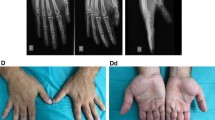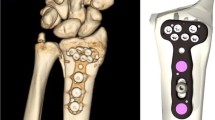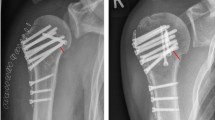Abstract
The treatment of osteoporotic distal radius fractures is frequently complicated by secondary displacements, mainly because of the posterior comminution. This work studies the advantages of injectable calcium phosphate cement, applied in addition to osteosynthesis with intrafocal pins. Our series comprises six osteoporotic patients with an average age of 77.5 years, showing a fracture of the distal radius osteosynthesized with pins. Cement has then been injected via the radial styloid. The result has been evaluated at an average interval of 14.7 months. The pain has been measured on an analogue visual scale and overall function by the DASH score. Mobility and gripping strength have been compared with the controlateral side. Radiographies have shown the presence of cement leakages, studied the resorption rate and measured secondary displacement. On the clinical level, the pain at the last examination was estimated at an average of 0.66 and total function at 30.28. Compared to the controlateral side, flexion-extension mobility was on average 95.3%, prono-supination 99%, and gripping strength 80.25%. There have been complaints of two resolutive reflex sympathetic dystrophy. Radiologically, the cement has distributed itself along the path of the trocar, in average quantities of 2 ml. Three anterior leaks of cement have been noticed, resorbed within a few months. The radio-ulnar index has lost on average 1.7 mm but the inclination of the radial glene has remained stable. At the last examination, resorption of the intra-osseous cement was partial three times and subtotal three times. Despite the paucity of the sample, it appears that adding calcium phosphate cement does not reduce secondary displacements. The asymptomatic extra-osseous leakages of cement disappeared on average in 6 months. The intra-osseous cement’s resorption rate was slower. Despite the partial results, calcium phosphate cements retain a place in the treatment of distal radius fractures, provided that they remain injectable and address unstable fractures in porotic bone. Cimentobrochage des fractures du radius distal ostéoporotique avec un substitut osseux phosphocalcique injectable: à propos d’une série préliminaire de 6 cas
Résumé
Le traitement des fractures du radius distal ostéoporotique est fréquemment compliqué de déplacements secondaires quel que soit le type d’ostéosynthèse. La cause est la comminution liée à la fragilité corticale postérieure et le tassement trabéculaire. Ce travail étudie l’intérêt d’un ciment phosphocalcique injectable, en complément d’une ostéosynthèse par broches. Notre série comporte six patientes ostéoporotiques d’âge moyen 77,5 ans, présentant une fracture du radius distal ostéosynthésée par broches intrafocales. Un ciment phosphocalcique a ensuite été injecté par la styloïde radiale. Le résultat a été évalué au recul moyen de 11,5 mois. La douleur a été mesurée sur une échelle visuelle analogique et la fonction globale par le score de DASH. La mobilité et la force de serrage ont été comparées au côté controlatéral. Les radiographies ont constaté la présence de fuites de ciment, étudié sa vitesse de résorption, et mesuré le déplacement secondaire. Sur le plan clinique, la douleur au dernier recul était côté en moyenne à 1,6 et la fonction globale à 34,3. Par rapport au côté controlatéral, la mobilité en flexion-extension était en moyenne de 95,3%, en prono-supination de 99%, la force de serrage de 80,25%. Deux algoneurodystrophies résolutives ont été déplorées. Radiologiquement, le ciment s’est réparti le long du trajet du trocart, avec une quantité moyenne de 200 mm3. Trois fuites antérieures de ciment ont été notées, résorbées en quelques mois. L’index radio-ulnaire a perdu en moyenne 1,7 mm, mais la pente de la glène radiale est restée stable. Au dernier recul, la résorption du ciment intraosseux était partielle 3 fois et subtotale 3 fois. Malgré la faiblesse de l’échantillon, il apparaît que l‘adjonction d’un ciment phosphocalcique ne diminue pas les déplacements secondaires. La technique pourrait être améliorée en formant une cavité centromédullaire destinée à être comblée. Les fuites de ciment extra-osseuses, asymptomatiques, ont disparu en moyenne en 6 mois. La vitesse de résorption du ciment intraosseux était plus lente. Malgré des résultats partiels, les ciments phosphocalciques conservent une place dans le traitement des fractures du radius distal, à condition de rester injectables, et de s’adresser à des fractures instables en os porotique.

Similar content being viewed by others
References
Cassidy C, Jupiter JB, Cohen M, Delli-Santi M, Fennell C, Leinberry C, Husband J, Ladd A, Seitz WR, Constanz B (2003) Norian SRS cement compared with conventional fixation in distal radial fractures. A randomized study. J Bone Joint Surg 85A:2127–2137
Castaing J, le club des dix (1964) Les fractures récentes de l’extrémité inférieure du radius chez l’adulte. Rev Chir Orthop 50:233–245
Charnley J (1970) Acrylic cement in orthopedic surgery. Churchill Livingstone, Edinburgh, pp 67–71
Consensus development conference (1993) Diagnosis, prophylaxis and treatment of osteoporosis. Am J Med 94:646–650
Harley BJ, Scharfenberger A, Beaupre LA, Jomha N, Weber DW (2004) Augmented external fixation versus percutaneous pinning and casting for unstable fractures of the distal radius—a prospective randomized trial. J Hand Surg 29A:815–824
Jeyam M, Andrew JG, Muir LT, Mcgovern A (2002) Controlled trial of distal radial fractures treated with a resorbable bone mineral substitute. J Hand Surg 27B:146–149
Judet T, Piriou P, Thomasson E (1998) Traitement orthopédique des fractures de Pouteau-Colles selon R. Judet. In: Les fractures du radius distal, Cahiers d’Enseignement de la SOFCOT, no 67. Paris: Expansion Scientifique Française, pp 58–66
Kapandji AI (1976) L’ostéosynthèse par double embrochage intrafocal: traitement fonctionnel des fractures non-articulaires de l’extrémité inférieure du radius. Ann Chir 30:903–908
Kiyoshige Y (1995) Bone cementing of distal radial fractures in elderly. In: Saffar P, Cooney NP (eds) Fractures of the distal radius. Martin Dunitz, London, pp 84–88
Kopylov P, Jonsson K, Thorngren KG, Aspenberg P (1996) Injectable calcium phosphate in the treatment of distal radial fractures. J Hand Surg 21B:768–771
Kopylov P, Adalberth K, Jonsson K, Espendberg P (2002) Norian SRS versus functional treatment in redisplaced distal radial fractures : a randomized study in 20 patients. J Hand Surg 27B:538–541
Lacout JL, Mejdoubi E,Hamad M (1996) Crystallisation mechanism of calcium phosphate cement for biological uses. J Mat Sci Mat Med 7:371–374
Lewis R (1950) Colles fracture–causative mechanism. Surgery 27:427–436
Limousin M, Benoit O, Chantelot, C, Gueguen G, Strouk G, Fontaine C (2003) A 36 months prospective study of 12 fractures of the distal radius by anterior plate with posterior intrafocal pinning. Chir main 22:138–143
Liverneaux PA (2003) Treatment of bony fibrous dysplasia with calcium–phosphate cement: a case report. Rev Chir Orthop 89:532–536
Liverneaux PA (2004) Experimental increase of osteoporotic distal radius strength using a calcium phosphate cement. Chir main 23:37–44
Liverneaux PA (2004) What wrist fracture did Pouteau actually describe? Chir main 23:298–304
Liverneaux PA (2005) Osteoporotic distal radius curettage-filling with an injectable calcium phosphate cement. A cadaveric study. Eur J Orthop Surg Traumatol 15:1–6
Mejdoubi E, Lacout JL, Heughebaert C, Michaud P (1994) Optimization of hydraulic calcium phosphate cement. Adv Mat Res 1:163–172
Obert L, Vichard PG, Garbuio P, Tropet Y (2001) Osteosynthesis of distal radius fracture by dorsal plate: advantages and drawbacks. Chir main 20:436–446
Obert L, Leclerc G, Lepage D, Forterre O, Tropet Y, Garbuio P (2004) Fractures of the distal radius treated by osteosynthesis and injectable bone substitute: a prospective study of 39 patients. Rev Chir Orthop 90:613–620
Riggs BL, Melton LJ (1983) Evidence for two distinct syndromes of involutional osteoporosis. Am J Med 75:899–901
Sakano H, Koshino T, Takeuchi R, Sakai N, Saito T (2001) Treatment of the unstable distal radius fracture with external fixation and a hydroxyapatite spacer. J Hand Surg 26A:923–930
Sanchez-Sotelo J, Munuera L, Madero R (2000) Treatment of fracture of the distal radius with a remodellable bone cement: a prospective, randomized study using Norian SRS. J Bone Joint Surg 82B:856–863
Terver S, Reig S, Fortunato-Robinot B (2001) Déplacement secondaire des fractures extra et intra-articulaires de l’extrémité distale du radius. Rev Chir Orthop 87:124–129
Theiss F, Apelt D, Brand B, Kutten A, Zlinszky K, Bohner M, Matter S, Frei C, Auer JA, Von Rechenberg B (2005) Biocompatibility and resorption of a brushite calcium phosphate cement. Biomaterials 26:4383–4394
Author information
Authors and Affiliations
Corresponding author
Rights and permissions
About this article
Cite this article
Liverneaux, P., Vernet, P., Robert, C. et al. Cement pinning of osteoporotic distal radius fractures with an injectable calcium phosphate bone substitute: report of 6 cases. Eur J Orthop Surg Traumatol 16, 10–16 (2006). https://doi.org/10.1007/s00590-005-0018-3
Received:
Accepted:
Published:
Issue Date:
DOI: https://doi.org/10.1007/s00590-005-0018-3




